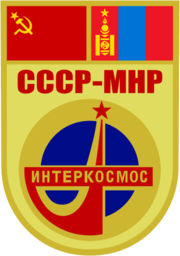
Back Союз 39 Bulgarian Soiuz 39 Catalan Sojuz 39 Czech Sojus 39 German Soyuz 39 Spanish سایوز۳۹ Persian Sojuz 39 Finnish Soyouz 39 French Soiuz 39 Galician סויוז 39 HE
| COSPAR ID | 1981-029A |
|---|---|
| SATCAT no. | 12366 |
| Mission duration | 7 days, 20 hours, 42 minutes, 3 seconds |
| Orbits completed | 124 |
| Spacecraft properties | |
| Spacecraft type | Soyuz 7K-T |
| Manufacturer | NPO Energia |
| Launch mass | 6,800 kilograms (15,000 lb) |
| Crew | |
| Crew size | 2 |
| Members | Vladimir Dzhanibekov Jügderdemidiin Gürragchaa |
| Callsign | Pamir (Pamirs) |
| Start of mission | |
| Launch date | 22 March 1981, 14:58:55 UTC |
| Rocket | Soyuz-U |
| Launch site | Baikonur 1/5 |
| End of mission | |
| Landing date | 30 March 1981, 11:40:58 UTC |
| Landing site | 175 km SE of Dzhezkazgan |
| Orbital parameters | |
| Reference system | Geocentric |
| Regime | Low Earth |
| Perigee altitude | 197.5 kilometres (122.7 mi) |
| Apogee altitude | 282.8 kilometres (175.7 mi) |
| Inclination | 51.6 degrees |
| Period | 89.1 minutes |
| Docking with Salyut 6 | |

Soyuz programme (Crewed missions) | |
Soyuz 39 was a 1981 Soviet crewed space flight to the Salyut 6 space station. It was the fifteenth expedition, and carried the eighth international crew to the orbiting facility.[1] The crew visited Vladimir Kovalyonok and Viktor Savinykh, who had reached Salyut-6 ten days prior.
The flight carried Vladimir Dzhanibekov and Jügderdemidiin Gürragchaa into space. With this mission, Gürragchaa became the first Mongolian, and second Asian cosmonaut.
The Mongolian contribution for this mission had begun in 1967, when the president of the Mongolian Academy of Sciences Bazaryn Shirendev attended a conference of scientists from socialist countries in Moscow, where the Intercosmos project was announced.[2] Dzhanibekov and Gürragchaa performed about thirty experiments during the course of the mission.[3]
- ^ The mission report is available here: http://www.spacefacts.de/mission/english/soyuz-39.htm
- ^ "Сансрын хамтарсан нислэг". Retrieved 21 March 2012.
- ^ "Зөвлөлт-монголын сансрын хамтарсан нислэгийн үеэр хийсэн эрдэм шинжилгээний сорил, туршилтууд". Retrieved 21 March 2012.